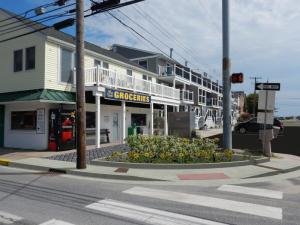Two projects are set to get underway in the fall in Dewey Beach, both designed to reduce flooding and reduce pollution flowing into Rehoboth Bay.
Working with the Center for the Inland Bays, Dewey plans to install an $85,660 stormwater retention area on Read Avenue and a $173,000 protective dune near Monigle Park.
Dewey Mayor T.J. Redefer said the projects are necessary to fight the effects of global warming.
“We’re proud of our town, and we have to work together with the state to protect our town, street by street,” he said.
The projects stem from a stormwater master plan developed by the CIB that studied the area from Saulsbury Street south to Collins Avenue.
The study found stormwater runoff flows from Coastal Highway’s ocean side through storm drains and on the road surface toward Rehoboth Bay, then enters the bay through nine outfall pipes.
Read Avenue has the largest pipe, and runoff from the area’s 30 acres of mostly impervious surface collects bayside at the end of Read Avenue.
CIB science and restoration coordinator Marianne Walch said intense development has contributed to Dewey’s flooding problems.
“The storm drain system and outfall were built years before all of the development occurred in town, and it cannot adequately handle that much runoff,” Walch said. “This leads to flooding on Read Avenue, mostly on the bay side.”
Walch said flooding is not as much a problem on the ocean side, but runoff from pavement on the ocean side contributes to flooding on the bay side.
Dewey’s low-lying geography and sea level rise have also challenged stormwater management. To address the problem, CIB has proposed projects on Read Avenue’s bayside and oceanside streets.
A planted bioretention area and trench outside the Little Store grocery will reduce oceanside runoff, bayside flooding, and treat polluted stormwater.
This stormwater treatment area will have permeable pavers so water can seep into and be filtered by the soil. A charcoal-like material called biochar will be added to the soil to help remove pollution from the runoff and enhance plant growth.
CIB officials say the project will improve drainage and treatment for a 2.7-acre area to reduce Read Avenue flooding and impervious surfaces. Reducing and filtering stormwater will also reduce pollution of Rehoboth Bay.
This project will be funded by a Community Water Quality Improvement Grant and Dewey Beach. Grant funding comes from the Delaware Department of Natural Resources and Environmental Control’s Water Infrastructure Advisory Council.
A preliminary cost estimate of $104,000 was reduced to $85,660 after CIB submitted the grant proposal. A $60,660 grant was awarded; Dewey commissioners voted in September 2017 to provide the remaining $25,000.
Walch said a shoreline project on Read Avenue’s bayside end next to Monigle Park will take place at the same time to save costs.
“This is a location that experiences frequent flooding during large storms,” she said. “All of the runoff from a 30-acre drainage area collects at that outfall point.”
Walch said a living shoreline with a 3.5-foot-high dune will protect against bayside flooding. About 160 feet of eroding shoreline will be stabilized with rock and oyster shell bags, and a tidal marsh area will also be restored.
A new pathway will lead to the bay and a kayak launch, and an offshore small oyster shell bag reef will dissipate wave energy and provide habitats for fish and other animals.
A tide gate will be added to the existing stormwater outfall pipe to allow stormwater to flow out and prevent bay water from flowing back into the storm drain system during high tides.
The project’s estimated cost is about $173,000. A Community Water Quality Improvement Grant will cover $75,000, Dewey contributed another $35,000 and DelDOT is providing $60,000 in in-kind services.















































